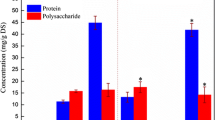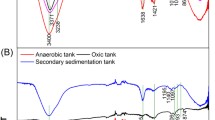Abstract
The disposal of wastewater sludge generated during the treatment of the various municipal and industrial wastewaters is a major environmental problem. In this study the thermophilic bacterium Bacillus licheniformis, which enhances the efficiency of sludge reduction, was isolated from waste activated sludge acclimated to 55 °C. The resulting suspended solids’ degradation was 12 % and chemical oxygen demand solubilization was 18 %. To further enhance the sludge reduction potential, extra polymeric substances, which play a major role in the formation of flocs, were removed. A chemical extractant, ethylenediaminetetraacetate that is also a cation binding agent, was used to remove the extra polymeric substances. After the removal of extra polymeric substances, the suspended solids’ degradation increased from 12 to 23 % and the chemical oxygen demand solubilization increased from 18 to 25 %. These observations confirm that Bacillus licheniformis enhanced sludge reduction in non-flocculated sludge (with the removal of extra polymeric substances) as compared to flocculated sludge (without the removal of extra polymeric substances).




Similar content being viewed by others
References
Abzac PD, Francois B, Ericl VH, Piet NLL, Gilles G (2009) Extraction of extracellular polymeric substances from anaerobic granular sludges: comparison of chemical and physical extraction protocols. Appl Microbiol Biotechnol 85:1589–1599. doi:10.1007/s00253-009-2288-x
American Public Health Association (APHA) (2005) Standard methods for the examination of water and wastewater, 21st edn. APHA, Washington, DC
Bomio M, Sonnleitner B, Fiechter A (1989) Growth and biocatalytic activities of aerobic thermophilic populations in sewage sludge. Appl Microbiol Biotechnol 32(3):356–362. doi:10.1007/BF00184989
Burgess JE, Pletschke BI (2008) Hydrolytic enzymes in sewage sludge treatment: a mini-review. Water SA (Online) 34(3):343–349. http://eprints.ru.ac.za/1371/. http://eprints.ru.ac.za/1371/1/Pletschke_hydrolic_enzymes.pdf
Chenel JP, Tyagi RD, Surampalli RY (2008) Production of thermostable protease enzyme in wastewater sludge using thermophilic bacterial strains isolated from sludge. Water Sci Technol 57(5):639–645. doi:10.2166/wst.2008.004
Chul-Hwi P, Yoon-Sun B, Gee-Bong H (2010) Implementation of an excess sludge reduction step in an activated sludge process. J Environ Sci Health A Tox Hazard Subst Environ Eng 45(6):709–718. doi:10.1080/10934521003648925
Comte S, Guibaud G, Baudu M (2006) Relations between extraction protocols for activated sludge extracellular polymeric substances (EPS) and EPS complexation properties part 1. Comparison of the efficiency of eight EPS extraction methods. Enzyme Microb Technol 38(1–2):237–245. doi:10.1016/j.enzmictec.2005.06.016
Daniel HZ, Carlan CJ, Richard ES (2008) Metal stimulation and municipal digester thermophilic/mesophilic activity. J Env Eng 134(1):42–47. doi:10.1061/(ASCE)0733-9372(2008)134:1(42)
Greg J (2010) Universal bacterial identification by PCR and DNA sequencing of 16S rRNA gene. PCR Clin Microbiol 3:209–214. doi:10.1007/978-90-481-9039-3_28
Guo-Ping S, Han-Qing Y, Zhou Y (2004) Extraction of extracellular polymeric substances from the photosynthetic bacterium Rhodopseudomonas acidophila. Appl Microbiol Biotechnol 67:125–130. doi:10.1007/s00253-004-1704-5
Henneken L, Nortemann B, Hempel D (1995) Influence of physiological conditions on EDTA degradation. Appl Microbiol Biotechnol 44(1–2):190–197. doi:10.1007/BF00164501
Hirst CN, Cyr H, Jordan IA (2003) Distribution of exopolymeric substances in the littoral sediments of an oligotrophic lake. Microb Ecol 46(1):22–32. doi:10.1007/s00248-002-1064-6
Jeongsik K, Chulhwanpark P, Tak-Hyun K, Myunggu L, Sangyong K, Seung-Wook K, Jinwon L (2003) Effects of various pretreatments for enhanced anaerobic digestion with waste activated sludge. J Biosci Bioeng 95(3):271–275. doi:10.1263/jbb.95.271
Jorand F, Boue-Bigne F, Block JC, Urbain V (1998) Hydrophobic/hydrophilic properties of activated sludge exopolymeric substances. Water Sci Technol 37(4–5):307–315. doi:10.1016/S0273-1223(98)00123-1
Kim YH, Bae JH, Oh BK, Lee WH, Choi JW (2002) Enhancement of proteolytic enzyme activity from Bacillus stearothermophilus for a thermophilic aerobic digestion process. Bioresour Technol 83(2):157–164. doi:10.1016/S0960-8524(01)00177-8
Krishna SBN, Kodidhela LD (2005) Optimization of thermostable alkaline protease production from species of Bacillus using rice bran. Afr J Biotechnol 4(7):724–726
Leroy C, Delbarre C, Gillebaert F, Compere C, Combes D (2008) Effect of commercial enzymes on the adhesion of a marine biofilm forming bacterium. Biofouling 24(1):11–22. doi:10.1080/08927010701784912
Li XI, Yang SF (2007) Influence of loosely bound extracellular polymeric substances (EPS) on flocculation, sedimentation and dewaterability of activated sludge. Water Res 41(5):1022–1030. doi:10.1016/j.watres.2006.06.037
Liu H, Fang HHP (2002) Extraction of extracellular polymeric substances (EPS) of Sludges. J Biotechnol 95(3):249–256. doi:10.1016/S0168-1656(02)00025-1
Morgan JW, Forster CF, Evison L (1990) A comparative study of the nature of biopolymers extracted from anaerobic and activated sludges. Water Res 24(6):743–750. doi:10.1016/0043-1354(90)90030-A
Nybroe O, Jorgensen PE, Henze M (1992) Enzyme activities in waste water and activated sludge. Water Res 26(5):579–584. doi:10.1016/0043-1354(92)90230-2
Olajuyigbe FM, Ajene OJ (2005) Production dynamics of extracellular protease from bacillus species. Afr J Biotechnol 4(8):776–779
Orgaz B, Kives J, Pedregosa AM, Monistrol IF, Laborda F, Sanjose C (2006) Bacterial biofilms removal using fungal enzymes. Enzyme Microb Technol 40:51–56. doi:10.1016/j.enzmictec.2005.10.037
Ramesh A, Duu-Jong L, Hong SG (2006) Soluble microbial products (SMP) and soluble extracellular polymeric substances (EPS) from wastewater sludge. J Env Biotechnol 73:219–225. doi:10.1007/s00253-006-0446-y
Rosenberger S, Kraume M (2003) Filterability of activated sludge in membrane bioreactor. Desalination 151(2):195–200. doi:10.1016/S0011-9164(02)00998-0
Kashid SG, Ghosh JS (2010) Production, isolation and characterization of exotoxin produced by Bacillus cereus NCIM-2156 and Bacillus licheniformis NCIM-5343. Br J Pharmacol Toxicol 1(1):50–55
Sponza DT (2004) Properties of four biological flocs as related to settling. J Environ Eng 130(11):1289–1300. doi:10.1061/(ASCE)0733-9372(2004)130:11(1289)
Subramanian SB, Yan S, Tyagi RD, Surampalli RY (2008) Isolation and molecular identification of extracellular polymeric substances (EPS) producing bacterial strains for sludge dewatering. J Environ Sci Health A Tox Hazard Subst Environ Eng 43(13):1495–1503. doi:10.1080/10934520802293602
Sun Y, Clinkenbeard KD, Clarke C, Cudd L, Hagh-Lander SK, Dubo SM (1999) Pasteurella haemolytica leukotoxin induced apoptosis of bovine lymphocytes involves DNA fragmentation. Vet Microbiol 65(2):153–166. doi:10.1016/S0378-1135(98)00286-7
Takahashi E, Ledauphin J, Goux D, Orvain F (2009) Optimising extraction of extracellular polymeric substances (EPS) from benthic diatoms: Comparison of efficiency of six EPS extraction methods. Mar Freshw Res 60(12):1201–1210
Tapia JM, Munoz JA, Gonzalez F, Blazquez LM, Malki M (2009) Extraction of extracellular polymeric substances from the acidophilic bacterium Acidiphilium 3.2Sup(5). Water Sci Technol 59(10):1959–1967. doi:10.2166/wst.2009.192
Victoria EBL, Deokjin J (2004) Isolation of protease producing aerobic thermophilic bacteria for digestion of excess sludge. Korean J Env Eng 28(4):604–610
William WB, David LS (2000) Effects of EDTA on pollutant metal removal by municipal wastewater treatment plants. In: International symposium on specialty chemicals in the environment, San Francisco, vol 40(1), pp 150–152
Wingender J, Neu TR, Flemming HC (1999) What are bacterial extracellular polymeric substances? In: Wingender J, Neu TR, Flemming HC (eds) Microbial extracellular substances: characterization, structures and function, chapter 3. Springer, Berlin, pp 1–19
Xiangliang P, Jing L, Daoyong Z, Xi C, Lanhai L, Weljuan S, Jainying Y (2010) A comparison of five extraction methods for extra polymeric substances (EPS) from biofilm by using three-dimensional excitation-emission matrix (3DEEM) fluorescence spectroscopy. Water SA (Online) 36(1):111–116
Xuesong L, Hongzhi M, Qunhui W, Shoichiro M, Toshinari M, Ogawa HI (2009) Isolation, identification of sludge-lysing strain and its utilization in thermophilic aerobic digestion for waste activated sludge. Bioresour Technol 100(9):2475–2481. doi:10.1016/j.biortech.2008.12.019
Yang Q, Luo K, Li X, Wang D, Zheng W, Zeng G, Liu J (2010) Enhanced efficiency of biological excess sludge hydrolysis under anaerobic digestion by additional enzymes. Bioresour Technol 101:2924–2930. doi:10.1016/j.biortech.2009.11.012
Zhang J, Wang R, Ziang P, Liu Z (2002) Production of an exopolysaccharides bioflocculant by Sorangium cellulosum. Lett Appl Microbiol 34(3):178–181. doi:10.1046/j.1472-765x.2002.01068.x
Zhang X, Bishop PL, Kinkle BK (1999) Comparison of extraction methods for quantifying extracellular polymers in biofilms. Water Sci Technol 39(7):211–218. doi:10.1016/S0273-1223(99)00170-5
Acknowledgments
The authors would like to thank the Department of Biotechnology, India for financial assistant for this project (BT/PR13124/GBD/27/192/2009) under their Rapid Grant for Young Investigator (RGYI) scheme.
Author information
Authors and Affiliations
Corresponding author
Rights and permissions
About this article
Cite this article
Merrylin, J., Kaliappan, S., Adish Kumar, S. et al. Effect of extracellular polymeric substances on sludge reduction potential of Bacillus licheniformis . Int. J. Environ. Sci. Technol. 10, 85–92 (2013). https://doi.org/10.1007/s13762-012-0141-8
Received:
Revised:
Accepted:
Published:
Issue Date:
DOI: https://doi.org/10.1007/s13762-012-0141-8




